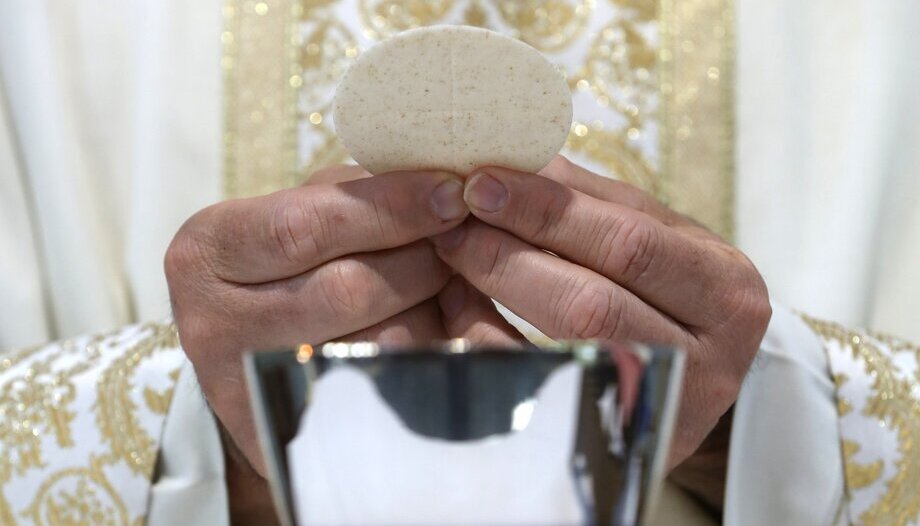A first point that develops the document is the Liturgy in the today of salvation history. In this first epigraph, the Pope situates us in the Paschal Mystery, the true center of the liturgical theology of the Council's Constitution on the Liturgy, the Sacrosanctum Concilium. The Last Supper, the Cross of Christ and the Resurrection, the Paschal Mystery, appear as the only true and perfect worship pleasing to the Father.
The liturgy is the means that the Lord has left us to take part in this unique and admirable event in the history of Salvation. And it is a means that we live in the Church. "From the beginning, the Church, enlightened by the Holy Spirit, has understood that what was visible in Jesus, what could be seen with the eyes and touched with the hands, his words and gestures, the concrete of the Incarnate Word, has passed into the celebration of the sacraments" (Letter, n. 9).
Encounter with Christ
Directly related to what we have said so far is the second epigraph of the Charter: The Liturgy, the place of encounter with Christ. This subtitle reminds us of a very significant expression from the Letter that John Paul II wrote 25 years after the publication of the Sacrosanctum Concilium: The liturgy is the privileged place of encounter with God and with the one He sent, Jesus Christ" (St. John Paul II, Apostolic Letter "The Liturgy is the privileged place of encounter with God and with the one He sent, Jesus Christ").. Vicesimus quintus annus, n. 7). Herein lies all the powerful beauty of the liturgy, Francis will say: it is an encounter with Christ, for we cannot forget that "the Christian faith is either a living encounter with Christ or it is not" (Letter, n. 10).
The liturgy is a true encounter with Christ, not just a vague recollection. An encounter that began in Baptism, an event that marks the life of all of us. And this encounter with Christ in Baptism, true death and resurrection, makes us children of God, members of the Church and thus we experience the fullness of the worship of God. "In fact, there is only one act of worship that is perfect and pleasing to the Father, the obedience of the Son, the measure of which is his death on the cross. The only possibility of participating in his offering is to be sons in the Son. This is the gift we have received. The subject that acts in the Liturgy is always and only Christ-Church, the Mystical Body of Christ" (Letter, n. 15).
Drinking from the liturgy
The Pope then wants to remind us, as he did on the occasion of the Vatican Council and the liturgical movement that preceded it, that the liturgy is the "primary and necessary source from which the faithful must drink the truly Christian spirit" (Sacrosanctum Concilium, n. 14). Therefore, "with this letter I would simply like to invite the whole Church to rediscover, guard and live the truth and power of the Christian celebration. I would not want the beauty of Christian celebration and its necessary consequences in the life of the Church to be disfigured by a superficial and reductive understanding of its work, or worse, to be instrumentalized in the service of some ideological vision" (Letter, n. 16). The objective of the Letter, beyond some sensationalist headlines, is clear reading these words of Francis.
Faced with the danger of Gnosticism and Pelagianism, to which the Holy Father has referred at length in his programmatic letter Evangelii gaudium, the Letter places before our eyes the value of the beauty of the truth of the Christian celebration. "The liturgy is the priesthood of Christ revealed and given to us in his Passover present and active today through sensible signs (water, oil, bread, wine, gestures, words) so that the Spirit, immersing us in the paschal mystery, may transform our whole life, conforming us ever more to Christ" (Letter, n. 21).
In this paragraph is contained all the beauty and depth of the liturgy: the mystery in which we participate, which is made present by means of sensible signs, which configures us to the dead and risen Christ, transforming us into him. Beauty which, as the Roman Pontiff reminds us, is not a simple ritual aestheticism, or the care only for the external formality of the rite or the rubrics.
Taking care of the liturgy
Logically, this is necessary so as not to "confuse the simple with banal sloppiness, the essential with ignorant superficiality, the concrete of the ritual action with an exaggerated practical functionalism" (Letter, n. 22). For this reason it is necessary to take care of all aspects of the celebration, to observe all the rubrics, but without forgetting that it is necessary to foster "wonder before the paschal mystery, an essential part of the liturgical action" (Letter, n. 24). An awe that goes beyond the expression of the meaning of the mystery. "Beauty, like truth, always generates wonder and, when it refers to the mystery of God, leads to adoration" (Letter, n. 25). Awe is an essential part of the liturgical action, because it is the attitude of one who knows that he is before the peculiarity of symbolic gestures.
After this first introductory part, the Pope asks: how can we recover the ability to live the liturgical action to the full? And the answer is clear: "The reform of the Council has this objective" (Letter, n. 27). But the Pope does not want the non-acceptance of the reform, as well as a superficial understanding of it, to distract from finding the answer to the question we asked earlier: how can we grow in the ability to live the liturgical action fully, how can we continue to be amazed at what happens before our eyes in the celebration? And Francis' clear answer: "We need a serious and vital liturgical formation" (Letter, n. 31).
Liturgical formation
Formation for the liturgy and formation from the liturgy are the two aspects that the following letter deals with. In this formation for the liturgy, study is only the first step to be able to enter into the celebrated mystery, since in order to be able to guide on the path, it is necessary to travel it first. Nor should it be forgotten that formation for the liturgy "is not something that can be conquered once and for all: since the gift of the celebrated mystery surpasses our capacity for knowledge, this commitment must certainly accompany the ongoing formation of each one, with the humility of the little ones, an attitude that opens one to wonder" (Letter, n. 38).
As far as formation from the liturgy is concerned, being formed by it entails a real existential involvement with the person of Christ. "In this sense, the liturgy is not about knowledge, and its purpose is not primarily pedagogical (although it has its pedagogical value) but is praise, thanksgiving for the Passover of the Son, whose saving power comes into our lives" (Letter, n. 41). Therefore, the celebration has to do with the "reality of being docile to the action of the Spirit, who is at work in us, until Christ is formed in us. The fullness of our liturgical formation is conformation to Christ. I repeat: it is not a matter of a mental and abstract process, but of becoming him" (Letter, n. 41).
Union of heaven and earth
This existential involvement takes place sacramentally. Through the created signs that have been assumed and placed at the service of the encounter with the Word incarnate, crucified, dead, risen, ascended to the Father. The Pope's phrase is very beautiful when he recalls that the "liturgy gives glory to God because it allows us, here on earth, to see God in the celebration of the mysteries" (Letter, n. 43). And how can we once again become capable of symbols? How can we learn to read them in order to live them? First of all, Francis will say, by recovering confidence in creation. In addition, another question will be the education necessary to acquire the interior attitude that will allow us to situate and understand the liturgical symbols.
One aspect that the Charter points out to guard and to grow in the vital understanding of the symbols of the liturgy will be the ars celebrandi: the art of celebrating. An art that entails understanding the dynamism that describes the liturgy, being in tune with the action of the Spirit, as well as knowing the dynamics of symbolic language, its peculiarity and its efficacy (cf. Letter, nn. 48-50).
Liturgical silences
Pope Francis recalls that this theme concerns all the baptized and involves a common doing (walking in procession, sitting, standing, kneeling, singing, being silent, looking, listening...), which educates each faithful to discover the authentic uniqueness of his or her personality, not with individualistic attitudes, but being aware of being one body of the Church.
A particularly important gesture is silence. It is expressly foreseen by the rubrics (in the opening rites, in the liturgy of the Word, in the Eucharistic prayer, after communion). Silence is not a refuge to hide in an intimate isolation, suffering the ritual as if it were a distraction, but it is the symbol of the presence and action of the Holy Spirit.
Ars celebrandi
While the ars celebrandi The Pope points out that ordained ministers should take special care in this regard. There are various models of presiding, but what is fundamental is to avoid exaggerated personalism in the celebratory style. For this service of presiding to be done well, with artistry, it is of fundamental importance that the presbyter be aware that he is, in himself, one of the modes of the Lord's presence.
This will lead him not to forget that the Risen One must remain the protagonist, as in the Last Supper and the Cross and Resurrection. It is a matter of showing in the celebration that the Lord, and not the celebrant, is the protagonist. "The presbyter is trained to preside by means of the words and gestures which the Liturgy places on his lips and in his hands" (Letter, n. 59). It should always be kept in mind that the words and gestures of the liturgy are an expression, matured over the centuries, of the sentiments of Christ and help to be configured to him (cf. Redemptionis sacramentum, n. 5).
Purpose of the document
Pope Francis, as St. John Paul II and Benedict XVI repeatedly did, concludes by encouraging us to rediscover the richness of the Council's Constitution on the Sacred Liturgy, Sacrosanctum Concilium. At the same time, he reiterates, as he did at the beginning and at various points in the letter constituting his Leitmotiv, your filo rossoThe desire that this letter will help "to rekindle wonder at the beauty of the truth of the Christian celebration, to recall the need for authentic liturgical formation and to recognize the importance of an art of celebration that is at the service of the truth of the paschal mystery and of the participation of all the baptized, each according to the specificity of his or her vocation" (Letter, n. 62). These, and no others, are the underlying motivations of this beautiful Letter. A golden brooch to remind us of the importance of the liturgical year and of Sunday.
"Let us abandon polemics to listen together to what the Spirit is saying to the Church, let us maintain communion, let us continue to be amazed by the beauty of the Liturgy" (Letter, n. 65).








